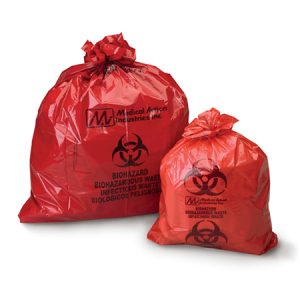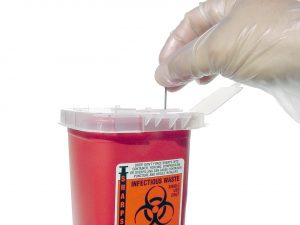Skill Group: Biosafety and Biosecurity
Handling Non-PPE Infectious Waste and Sharps
Dr. Jason Stull; Dr. Amanda Berrian; and Dr. Emily Feyes
Before You Start …
You’ve gotten rid of the contaminated PPE, but what about everything else? Is the procedure the same for bedding and supplies, as it is for PPE? What about the needles and other sharps?
Introduction
You know how to dispose of PPE, now let’s discuss how to properly dispose of everything else.
Learning Outcomes
By the end of this lesson, you should be able to:
- Identify key elements to dispose of non-PPE infectious waste
- Recall proper disposal of sharps
The key concepts described in the previous lesson are the same for the proper disposal of other contaminated items. The following materials are examples of items that should be disposed of using proper biohazard procedures if it has been in contact with infectious agents that could pose a risk to animal or human health:
- Bedding, animal waste (solid or liquid)
- Blood, tissues, organs, and carcasses
- Disposable absorbent pads, bandages, other disposable items used in patient care
- Cultures, discarded vaccines, and diagnostic specimens
Universal biohazard warning labels are used to alert users and bystanders of potential risks posed by specific materials. These warning labels are required on the following items:
- Containers with biohazardous materials
- Infectious waste containers
- Refrigerators, freezers, or other equipment used to store infectious materials
- Entrances to areas where biohazardous materials are stored or used
These labels can be used in sticker form or can be printed on red bags; as is the case with biohazard waste bags.


Want more information?
Sharps Disposal
Placing sharp items, such as needles, in typical trash receptacles could result in injury to you or others. It is important to have proper sharps containers on hand so you can reduce the risk of a puncture wound and related infections. Biohazard sharps containers are readily available for purchase or may be provided by pharmaceutical manufactures. In the event a sharps container is not available, any leak-proof, rigid, puncture resistant, container with a lid can be used to dispose of non-infectious waste sharps, as long as it is labeled as sharps. Liquid laundry detergent bottles are a great alternative to dispose of sharps in a safe manner in municipal waste.
Items that should be discarded as sharps:
- Hypodermic needles
- Scalpel blades
- Lancets
- Broken glass
- Razor blades

If the sharp could be contaminated with an infectious agent, it needs to be placed in a sharps container which should be disposed of using proper biohazards waste procedures. The label on the sharps containers should include not only sharps, but also a universal biohazard symbol.
For more information see the Ohio EPA guidance on sharps
Wrapping Up
You can dispose of infectious wastes and sharps correctly! You’ll need to use these guidelines each day to reduce the risk of injury or illness to yourself and other.